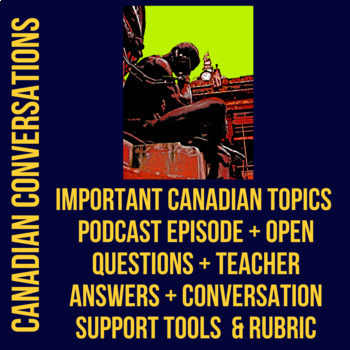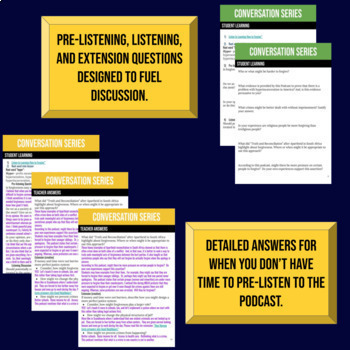Slavery in Canada- Beyond Underground Railroad- Listen, Short Ans., Conversation
- Google Slides™

What educators are saying
Description
Anti-black racism in Canada requires a more honest look at our past that includes slavery. This task starts with a 20 min podcast that grapples with why Canadians don't know beyond the Underground Railroad. The podcast, discussion questions, and answers within support your students on this difficult subject. Specifically, this podcast tells us slavery's cruel legacy compromises interracial relationships.
I intend this task to be one small piece of a much larger, ongoing conversation, and it is a good start.
This document contains:
1) Detailed teacher notes including links to the podcast.
2) Specific pre-listening, discussion, and extension questions.
3) An easy-marking rubric for the conversation.
4) Answers to all questions, so you don't have to listen to the podcast in advance.
5) Optional conversation supports: I suggest using these, for this topic:
- Student reflection on conversation skills.
- Tips for discussion (poster).
- Making a plan for when emotions are hard, hand out.
- Suggestions of tactics and answer sheets for these.
6) Conversation record sheets/ templates (three options) and one example.
- There is one record sheet for a class of 15, one for 30, and one is editable for everything in between. I have also attempted to provide an online record sheet.
- There are examples so you can show your student record volunteer how to do it, and this visual helps your marking and the students to learn from the conversation.
If you liked this podcast assignment for your students, and you want more Canadian Conversations, please try these:
Episode 1: WE Charity Scandal
Episode 2: Canada's Dreamers: The Barriers they Face
Episode 3: BC Manhunt Suspects Last Message
Episode 4: RCMP Reckoning
Episode 5: Child Welfare Failure
Episode 6: Decriminalizing Drugs The Opioid Crisis
Episode 7: Terry Fox's Marathon of Hope (short podcast)
Episode 8: Canada's History of Slavery
Episode 9: Vaccine Hesitancy
OR
For more topics of Social Justice:
Black Lives Matter: Breonna Taylor
Systemic Racism: “Starlight Tours-” Systemic Racism in Canada
Wrongly Accused by an Algorithm: Facial Recognition & Policing
“Stay Black and Die": A Recent History of BLM
Vanessa Guillen Murdered- Latinx in the Military
Forgiveness & How it is Missing from the Justice System
Disability Rights- A History
Future Conversations will each have a different issue/ podcast, questions, and answer key. But the additional support materials (such as the templates) will be similar or the same.
Every conversation can yield an instant oral communication mark in a less threatening situation than a presentation or speech.
If you want more work similar to this topic and style, consider the High Interest and Skills Unit Series:




